Discover Upplands Väsby!
In the heart of Uppland, and 30 minutes north of Stockholm is Upplands Väsby. Take a journey of discovery in our beautiful rural district. You will get to see and experience a great deal, whether you make a day trip or if you stay for a few days. If you live locally you’ll find many favorite spots that are just around the corner.
We are surrounded by natural and cultural riches, with our trades and industries also flourishing alongside. The proximity to pulsating city life and Arlanda airport means that many people choose both to live and work in our municipality.Experience Väsby.Upplevelsestråket (Thoroughfare) is an alternative to the cycling net in the municipality. A natural experience between the municipality’s four lakes Norrviken, Edssjön, Bridge and Fysingen. The thoroughfare is divided into twelve stages and has an overall length of 37 kilometers. Maps are available at the Information Center located in central Väsby or download the map from www.upplandsvasby.se.www.upplandsvasby.se
Municipality Facts
Population
37 848
Area
84,28 km²
Regional Center
Upplands Väsby
County
Stockholm
More Information
Internet
www.upplandsvasby.se
Notes
Emergency
112
Police
114 14
Country Code
+46
Area Code
08
City
About
Discover Upplands Väsby!
In the heart of Uppland, and 30 minutes north of Stockholm is Upplands Väsby. Take a journey of discovery in our beautiful rural district. You will get to see and experience a great deal, whether you make a day trip or if you stay for a few days. If you live locally you’ll find many favorite spots that are just around the corner.We are surrounded by natural and cultural riches, with our trades and industries also flourishing alongside. The proximity to a pulsating city life and Arlanda airport means that many people choose both to live and work in our municipality.Experience Väsby.Upplevelsestråket (Thoroughfare) is an alternative to the cycling net in the municipality. A nature experience between the municipality's four lakes Norrviken, Edssjön, Bridge and Fysingen. The thoroughfare is divided into twelve stages and has an overall length of 37 kilometers. Maps are available at the Information Center located in central Väsby or download the map from www.upplandsvasby.se. www.upplandsvasby.se
See and Do
Swimming
Bathing
Outside Bathing:Bollstanäsbadet. You can bathe at Bollstanäsbadet located in the northern part of Norrviken. Sättra Recreation Area on Lake Mälaren offers a small bathing area and there is also a bathing area at Lake Fysingen, located behind Löwenströmska Hospital.
Kairobadet (Bathing)
Welcome to Kairobadet at Miami. Badet lies along the road to Runsor, route 880. One can also ride here in a beautiful forest tracks. Kairo has a sandy beach, swimming docks and jump tower. Next to the bathing area, outdoor serving offers simple food and a kiosk with ice cream, soft drinks, newspapers and more. +46 8-594 113 03
Outside Swimming Pools
Hasselbadet and Ekebobadet are operated by Väsby Swimming Association and is open during the summer. Please call for opening hours. +46 8-594 113 03
Vilundaparken (Sport Facility)
Vilundaparken is the municipality's largest sporting facility with swimming pool, ice rink, two sports halls, training area with all-weather track and a number of soccer fields. Next to the facility is also a lighted track. Husarvägen 25, Upplands Väsby
Family Activities
Welcome to Gunnes farm!
Gunnes Farm Open Air Museum is a reconstruction of a farm from the Viking era, or around the beginning of the 11th century. The farm is beautifully situated in a ancient burial area where the animals graze around the burial mounds. Several attractions. On Gunnes farm there are stone graves from the Iron Age and several rune stones. One of rune stones says - "Vibjörn cut the stone after Gunnes daughter, his wife." Gunnes farm is named after the rune stones. Animals on the farm. On Gunnes Farm are pigs, sheep, chickens and cows. The animals are not just a nice feature but play a key role. Their animals grazing helps to keep the soil and yard open. Live a day in the Iron Age! The farm is open to the public, and group tours are available for booking. School classes can come here and live "järnåldersliv" (Iron Age Life) for a day. Ryttargatan 270, Upplands Väsby +46 8-590 849 28
Fishing
Fishing
Sport fishing on Lake Mälaren. Fishing by hand is allowed on Lake Mälaren. No commercial fishing is allowed. Fishing licenses.Fishing licenses for Lake Edssjön, can be purchased at the Information Center. +46 8-590 976 00
Nature
Hiking
Here are the variety fine hiking areas with forests, lakes and farmland along the beaches of Lake Mälaren. Upplandsleden (Upplands Trails).Upplandsleden are marked hiking trails which go through large areas of Upland. The trails are 35 miles long and provides an overall view of Uppland's rich natural and cultural sites. There is a connecting route starting at Barkaby Station in Stockholm County. Via the nature areas around Järfälla, Upplands Väsby and Sigtuna leads you north to Uppsala County. Hiking In The Forest.Väsby Orienteering Club has produced orientation maps covering most of the municipality's forests. They can be purchased directly from the club or in the bookstore in Väsby Center. Sättra Nature Reserve.Sättra Nature Reserve is along Lake Mälaren and has an area of 150 hectares containing a varied nature of trees and open fields. The bird life flourishes in the area. To the North is Lake Fysingen which also has a rich bird life. Vildmarksskog (Wilderness Forest).In the south near the border to Sollentuna municipality, is Törnskogen which is one of Greater Stockholm last wilderness forests. Stream with Unique Inhabitants.Through central Väsby flows Väsbyån where the rare fish called Asp, swim upstream every year to spawn. The Asp is Upplands provincial fish.
Worth Seeing
www.upplandsvasby.seAncient Monuments
The Municipality has 76 Runic Inscriptions which have been discovered. They tell the story of the people who lived in Väsby around a thousand years ago. There are whole rune stones or fragments of them, inscriptions on boulders and on flat slabs of rock. On sale at the Information Center in Väsby Centrum is a booklet about these 76 runic inscriptions.Runic Inscription On A BoulderClose to the western shores of Lake Edsjön beside the track known as ‘kyrkstigen´ (the church path) there is a beautiful inscription on an boulder. It tells of journeys to foreign lands. The Runby and Skälby stones tell the story of bridge building. The most famous of the runic carvers here were Öpir, Fot and Visäte. Rune Stone in OxfordIn the gateway into the churchyard at Ed, there is a copy of a rune stone that was removed and taken to England in 1687. The original is in a museum in Oxford.Stone Ship (Burial Custom)There is a 56 meter long and 16 meter wide stone ship, forms part of a burial ground dating from 400 - 500 AD. Opinion is divided, but it is believed that it was here the people from the ancient stronghold buried their dead. Wolf pitThere are Iron Age graves here with a huge mound, a few large cairns and the stone ship. The 4 meter deep wolf pit still remains intact. The Ancient Stronghold of RunsaOn a headland high above the surface of the bay, lies the ancient stronghold of Runsa. This is where the ruling family of the district lived in the middle of the Iron Age, 300-500 AD.
Churches
Eds ChurchThe oldest church in the municipality is located at the north end of Lake Edssjön. The church was built in the late 1100's. The local people could not build a church themselves, so they obtained help from the monks in Sigtuna. The church is built of granite and was then plastered and trimmed, (i.e. given a coating of mortar and then painted). Originally, the windows were only small holes because glass was very expensive.PaintingsDuring the 1400's, the famous painter Albertus Pictor, painted pictures on the church walls. The priest preached in Latin, a language that the people did not understand, but with the help of the paintings on the walls, it was a way to understand some of what he said.A new-old churchIn 1918, comprehensive restoration work started on the church and the old paintings were uncovered again. Where the old paintings could not be revealed, new ones were painted by the artist, Olle Hjortsberg. The original base was found at Klockargården and a new upper section was cut for it. In 1937, a heating element was fitted and in 1956 a new church porch was built. It is used as a waiting room during christenings and weddings.Hammarby ChurchThe church was built in the 1200s and is situated alongside the road to Stockholm, at Lake Fysingen. There had probably been a timber church on the same site. The current church is built of stone and brick. No windows on the north wall.The wall to the north has no windows since the people wanted to shut out everything from the north, such as the Evil One, the coldness and the darkness. Earth floor with straw.In the beginning, the church had an earth floor which was covered with straw at Christmas, to decorate the church before the festival. In the 1700s, people stopped laying the straw since it could easily catch fire. Cold in the church.In the beginning, the church was heated with iron stoves. It was 1936 when the first electric heating system was installed. Graves under the floor.The walls of the church have always been painted white. Under the floor, graves dating from the 1600s been found. The floor is now covered with bricks. The church porch.Along the long south wall is the church porch, which was built in the 1400s. Prior to that, it is believed that a timber porch had stood in the same place. Altar cabinet.In the church there is an old German altar cabinet, which was made about 500 years ago. It is now hanging on the north wall. Bell tower.The bell tower is up on Klockåsen (the bell ridge), opposite the church. It was built in 1626 and is made of wood.Fresta Church.Runestones in the church building.Fresta Church is located in Frestaby. The oldest part of the church was built in the 13th century. 15 Rune Stones were built into the walls of the church. Some people believe that they were built into it because they were easy to use as a building material. Others believe that they were put there to honour the people to whom they were originally raised. Most of the Rune Stones have now been removed and have been placed around the church.The church building becomes larger.In the 14th century, the church was altered so that it became twice as long. In the 15th century, the church was given wall paintings depicting the twelve apostles. The altar cabinet is from the same period and is similar to the altar cabinet at Hammarby church. Font gone astray.During the restoration work in the 18th century, the style of the font was considered to be too simple. It ended up at Odenslunda farm where it was used as a flower pot. In 1906 the font was discovered, still intact, and was put back in the church. In 1957, the Jarlabanke Stone, as it is called, was discovered. It had been built into the churchyard wall. Vilunda Church.Vilunda Church is the youngest church in the municipality and was consecrated on 7 December 1975. In the ceiling, there are rough beams and between them are the church's' windows. The ceiling lights symbolizes the starry firmament. The altar and font are made of Italian marble. East-West orientation.In line with tradition, the church is positioned with an east-west orientation. In 1979, the church was given a new organ with 30 pitches.Carillon.In the church steeple, there are two bells that ring together and a carillon with 22 bells. On a daily basis, people can hear psalms being played using the carillon.
Historical Buildings
Hembygdsgården - Local Heritage Center.Upplands Väsby´s Local Heritage Center is situated in Runby at Hagvägen 2. The Heritage Center consists of buildings that were included in one of the three households that formed a village called Nedre Runby. The area has been inhabited since the Viking era. Visit the summer café at Gårdstunet which is open every Wednesday and Sunday, May - August. For other programs, see the website www.upplandsvasbyhembygdsforening.se, the community board at gårdsgrinden, local newspapers or the events calendar at the municipality's website www.upplandsvasby.se. Old Pharmacy - Picchus Café The Pharmacy has been used as a restaurant, pharmacy, gift and weaving. Now, craftsmen occupy the house and on the upper floor is the cafe, Picchus Café. In 1913, a murder took place in the old pharmacy that was never solved. During the trial, the phrase, "kyss inte mig, kyss Carlsson" ("Don't kiss me, kiss Carlsson") was coined. Learn more about the Old Pharmacy murder at www.upplandsvasby.se. The PoorhouseA form of poor relief existed in Sweden from the 1600s. Poorhouses were built at that time. The farmers in the district had to donate food to the paupers. The Poorhouse in Fresta was built in 1838 and still remains today. Skid- och Friluftsfrämjandet (the Organisation for the promotion of outdoor life) now uses the old poorhouse, which now goes under the name of Främjartorpet. Dragontorpet (the soldier´s croft) One soldier´s croft still remains and it can be seen today in Skälby. The cottage is called Dragontorpet. The last family to live there at the beginning of the 1900s consisted of a husband, his wife and eleven children.Löwenströmska HospitalLöwenströmska Hospital is now a modern hospital with a special history. The hospital was built at the beginning of the 1800s by Gustav Adolf Löwenström who wanted to atone for the fact that it was his brother, Jakob Johan Anckarström, who murdered the king at the masked ball at the Royal Opera in 1792. www.upplandsvasbyhembygdsforening.se
Source
Med reservation för eventuella ändringar
Search companies in Upplands Väsby
Search Result
Found 0 matches






 বাংলা
বাংলা Dansk
Dansk Deutsch
Deutsch English
English Suomi
Suomi Ελληνικά
Ελληνικά Íslenska
Íslenska Nederlands
Nederlands Norsk
Norsk Português
Português Svenska
Svenska 简体中文
简体中文 繁體中文
繁體中文 Español
Español Italiano
Italiano 日本語
日本語 한국어
한국어 Polski
Polski Русский
Русский Türkçe
Türkçe
